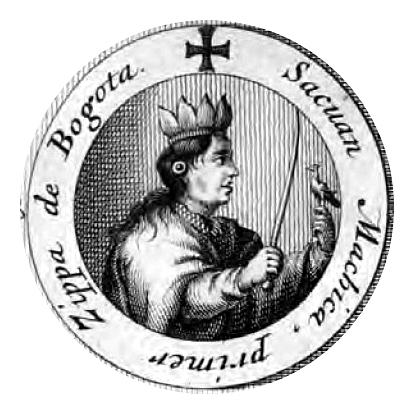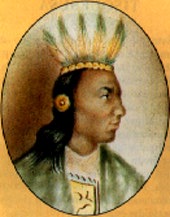|
Michuá
Michuá or Michica (died Chocontá, 1490) was the second ''zaque'' of Hunza, currently known as Tunja, as of 1470. His contemporary enemy ''zipa'' of the southern Muisca was Saguamanchica. Biography Little is known about the history of Michuá, who accessed the throne of the northern Muisca in 1470. He broke the political peace established under his predecessor Hunzahúa and fought a 16-year war with the southern enemies led by Saguamanchica. The latter, supported by his vassal Pasca conquered Fusagasugá and Tibacuy. Saguamanchica attempted to submit the ''cacique'' of Guatavita who asked Michúa for assistance. Michuá sent a messenger to Bacatá to negotiate the ''zipa'' would listen to the complaints of the ''cacique''. Saguamanchica was not amused by undermining his authority and abused the messenger. When Michuá found out about the mistreatment of his messenger he sent an army of forty thousand guecha warriors to the ''zipa''. Realising the strength of the army Saguamanchi ... [...More Info...] [...Related Items...] OR: [Wikipedia] [Google] [Baidu] |
Saguamanchica
Saguamanchica (died Chocontá, 1490) was the second ruler (''zipa'') of Muyquytá, as of 1470. His ''zaque'' enemy ruling over the northern area of the Muisca territory was Michuá. Alternative spellings of his name are Sacuan Machica, Saguanmachica and Saguanmanchica. Biography As former ''cacique'' of Chía, Saguamanchica accessed the throne of the southern Muisca around 1470. His predecessor, the first ''zipa'' of Muyquytá Meicuchuca, left him a rich kingdom with many guecha warriors. This led Saguamanchica to seek expansion of his ''zipazgo''. The first campaign of warfare he planned was to submit the eternal enemies of the Muisca, the Panche and the Sutagao to the west of the Muisca territories. The Carib-speaking peoples formed an alliance against their common and far outnumbered enemy. Saguamanchica together with his vassal Pasca defeated his enemies led by general Uzatama with ease and annexed Fusagasugá and Tibacuy. The expansion policies of the southern Muisc ... [...More Info...] [...Related Items...] OR: [Wikipedia] [Google] [Baidu] |
Muisca Confederation
The Muisca Confederation was a loose confederation of different Muisca rulers (''zaques'', ''zipas'', '' iraca'', and ''tundama'') in the central Andean highlands of present-day Colombia before the Spanish conquest of northern South America. The area, presently called Altiplano Cundiboyacense, comprised the current departments of Boyacá, Cundinamarca and minor parts of Santander. According to some Muisca scholars the Muisca Confederation was one of the best-organized confederations of tribes on the South American continent. Modern anthropologists, such as Jorge Gamboa Mendoza, attribute the present-day knowledge about the confederation and its organization more to a reflection by Spanish chroniclers who predominantly wrote about it a century or more after the Muisca were conquered and proposed the idea of a loose collection of different people with slightly different languages and backgrounds.Gamboa Mendoza, 2016 Geography Climate Muisca Confederation In the time ... [...More Info...] [...Related Items...] OR: [Wikipedia] [Google] [Baidu] |
Battle Of Chocontá
The Battle of Chocontá was one of a series of battles in the ongoing conflict between the northern and southern Muisca of pre-Columbian central Colombia. The battle was fought 1490 in the vicinity of Chocontá. An army of 50,000 southern Muisca guecha warriors, led by their ruler, or ''zipa'', Saguamanchica, attacked 60,000 northern Muisca troops commanded by Zaque Michuá, who was supported by the Cacique of Guatavita. Background In the decades before the Spanish conquistadors arrived in the central highlands of Colombia in 1537, the area was ruled by two main groups: the ''zacazgo'' of the northern Muisca and the ''zipazgo'' of the southern Muisca. While the two factions were joined in a confederation, they fought numerous wars to conquer terrain and to gain access to the resources of the area, mainly gold, copper, and emeralds. The northern Muisca inhabited the area of the current department of Boyacá while the southern Muisca lived in the present-day Cundinamarca Depart ... [...More Info...] [...Related Items...] OR: [Wikipedia] [Google] [Baidu] |
Quemuenchatocha
Quemuenchatocha or Quimuinchateca (named in the earliest sources Eucaneme) (Hunza, 1472–Ramiriquí, 1538) was the second-last '' hoa'' of Hunza, currently known as Tunja, as of 1490. He was the ruler of the northern Muisca when the Spanish conquistadores arrived in the Muisca highlands. His contemporary enemy '' psihipquas'' of the southern Muisca were successively Nemequene and Bogotá. Biography Eucaneme was eighteen years old when he accessed the throne, succeeding his predecessor Michuá as ruler of the northern Muisca. His reign was cruel and under his tyranny the Muisca feared him. His rule was so brutal that when the Spanish conquerors entered the outskirts of the capital Hunza and found a hill with poles where bodies were dangling, they named it ''Cerro de la Horca'' ("Gallows Hill").Biography of Que ... [...More Info...] [...Related Items...] OR: [Wikipedia] [Google] [Baidu] |
Tunja
Tunja () is a city on the Eastern Ranges of the Colombian Andes, in the region known as the Altiplano Cundiboyacense, 130 km northeast of Bogotá. In 2018 it had a population of 172,548 inhabitants. It is the capital of Boyacá department and the Central Boyacá Province. Tunja is an important educational centre of well-known universities. In the time before the Spanish conquest of the Muisca, there was an indigenous settlement, called Hunza, seat of the ''hoa'' Eucaneme, conquered by the Spanish conquistadors on August 20, 1537. The Spanish city was founded by captain Gonzalo Suárez Rendón on August 6, 1539, exactly one year after the capital Santafé de Bogotá. The city hosts the most remaining Muisca architecture: Hunzahúa Well, Goranchacha Temple and Cojines del Zaque. Tunja is a tourist destination, especially for religious colonial architecture, with the Casa Fundador Gonzalo Suárez Rendón as oldest remnant. In addition to its religious and historical sites it ... [...More Info...] [...Related Items...] OR: [Wikipedia] [Google] [Baidu] |
Hunzahúa
Hunzahúa was the first ''zaque''; ruler of the northern Muisca with capital Hunza, named after him. His contemporary ''zipa'' of the southern Muisca was Meicuchuca. Biography Hunzahúa, heir of Idacansás, was a ''cacique'' in the sacred valley of the ''iraca'' and was chosen by the other ''caciques'' of the region to make peace between the battling parties. He became the first ''zaque'' of the northern Muisca region based in Hunza, present-day Tunja, and one of his policies was the ban on the use of weapons. According to Muisca scholar Javier Ocampo López, who wrote extensively about the religion and mythology of the Muisca, his mother was named Faravita and his sister Noncetá. Legend tells that Hunzahúa fell in love with his older sister and made her his wife when he left Hunza for Chipatá. Faravita, the mother of the ''zaque'', disagreed with the marriage of her two children and attacked the couple, spilling a bowl of chicha. This created the Hunzahúa Well. When Hunzah� ... [...More Info...] [...Related Items...] OR: [Wikipedia] [Google] [Baidu] |
Nemequene
Nemequene or Nemeguene (died 1514) was the third ruler (''zipa'') of Bacatá as of 1490. His ''zaque'' counterpart ruling over the northern area of the Muisca territory was Quemuenchatocha. Etymology Nemequene in the Chibcha language of the Muisca has two possible meanings, derived from the words ''nymy'', "jaguar" and ''quyne'', meaning either "bone" or "force". Biography Nemequene succeeded to the throne of the southern Muisca in 1490 after the death of his predecessor Saguamanchica in the Battle of Chocontá where the ''zaque'' of the northern Muisca Michuá had also died. While Nemequene wanted to continue the attacks against the northern Muisca, he had to face the dangers of the Panche to the west of his territory. Nemequene installed his nephew and legal successor Tisquesusa as army general to fight off the Panche with success. Looking to expand the territory of the southern Muisca, Nemequene succeeded in the conquest of other areas in the central highlands of Colomb ... [...More Info...] [...Related Items...] OR: [Wikipedia] [Google] [Baidu] |
Muisca Rulers
When the Spanish arrived in the central Colombian highlands, the region was organized into the Muisca Confederation, which had two rulers; the ''zipa'' was the ruler of the southern part and based in Muyquytá. The ''hoa'' was the ruler of the northern area and based in Hunza, known today as Tunja. Organization ''Psihipqua'' and ''hoa'' were the titles given to these rulers of the ancient confederation. Neither exercised absolute power, not rigid or strict control over those to whom they owed their power, so that they can be considered kings. However, these positions of power were of great honor and were surrounded by a rather elaborate ceremony. The position of the ''psihipqua'' was such that not even the members of the nobility dared to look him in the face, and it is said if the ''psihipqua'' needed to spit, someone would hold out a piece of rich cloth for him to spit on, because it would be sacrilegious for anything so precious as his saliva to touch the ground. Whoever hel ... [...More Info...] [...Related Items...] OR: [Wikipedia] [Google] [Baidu] |
Guatavita
Guatavita is a municipality and town of Colombia in the Guavio Province of the department of Cundinamarca. Guatavita is located 75 km northeast of the capital Bogotá. It borders Sesquilé and Machetá in the north, Gachetá and Junín in the east, Guasca in the south and in the west are Tocancipá and Gachancipá.Official website Guatavita - accessed 05-05-2016 History Before the on the , the central plateau in the Colombian |
Zaque
When the Spanish arrived in the central Colombian highlands, the region was organized into the Muisca Confederation, which had two rulers; the ''zipa'' was the ruler of the southern part and based in Muyquytá. The ''hoa'' was the ruler of the northern area and based in Hunza, known today as Tunja. Organization ''Psihipqua'' and ''hoa'' were the titles given to these rulers of the ancient confederation. Neither exercised absolute power, not rigid or strict control over those to whom they owed their power, so that they can be considered kings. However, these positions of power were of great honor and were surrounded by a rather elaborate ceremony. The position of the ''psihipqua'' was such that not even the members of the nobility dared to look him in the face, and it is said if the ''psihipqua'' needed to spit, someone would hold out a piece of rich cloth for him to spit on, because it would be sacrilegious for anything so precious as his saliva to touch the ground. Whoever hel ... [...More Info...] [...Related Items...] OR: [Wikipedia] [Google] [Baidu] |
Zipa
When the Spanish arrived in the central Colombian highlands, the region was organized into the Muisca Confederation, which had two rulers; the ''zipa'' was the ruler of the southern part and based in Muyquytá. The ''hoa'' was the ruler of the northern area and based in Hunza, known today as Tunja. Organization ''Psihipqua'' and ''hoa'' were the titles given to these rulers of the ancient confederation. Neither exercised absolute power, not rigid or strict control over those to whom they owed their power, so that they can be considered kings. However, these positions of power were of great honor and were surrounded by a rather elaborate ceremony. The position of the ''psihipqua'' was such that not even the members of the nobility dared to look him in the face, and it is said if the ''psihipqua'' needed to spit, someone would hold out a piece of rich cloth for him to spit on, because it would be sacrilegious for anything so precious as his saliva to touch the ground. Whoever hel ... [...More Info...] [...Related Items...] OR: [Wikipedia] [Google] [Baidu] |
Chocontá
Chocontá is a municipality and town of Colombia in the Almeidas Province, part of the department of Cundinamarca. It is located on the Pan-American Highway. In 1938 Chocontá had a population of 2,041. Etymology In the Chibcha language of the Muisca, Chocontá means: "Farmlands of the good ally" or "Garden of the neighbour".Official website Chocontá History Chocontá is located in the territories of the on the border between the area led by the '''' of[...More Info...] [...Related Items...] OR: [Wikipedia] [Google] [Baidu] |






